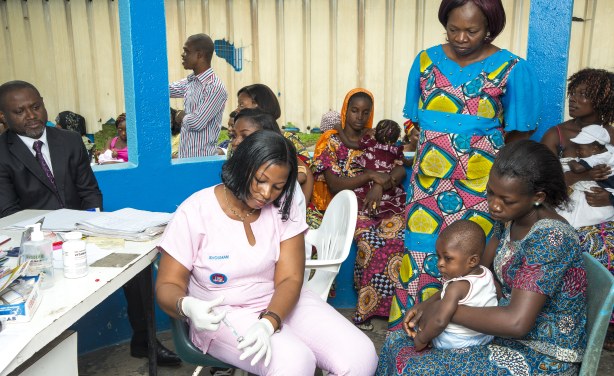Vaccine programmes can trigger fears of conspiracies and oppression. It’s time they got more collaborative.
The world is becoming more crowded. People flock to cities, millions flee smouldering conflicts in refugee camps, and some countries experience population booms.
As people’s space for living, building and farming shrinks, the challenges go beyond providing shelter, infrastructure and job opportunities: health becomes a serious issue as diseases spread quickly in cramped conditions.
Vaccines against some common and contagious diseases are widely available, meant to be making epidemic prevention easy. But fear of vaccinations is a real problem.
Vaccine resistance
Take the attack on a polio vaccination centre in Quetta, Pakistan earlier this year. A bomb attributed to the Taliban killed 13 policemen and two others, causing the government to suspend polio vaccinations in the region until more security could be organised.
The attack was widely condemned – but some claimed it was a justified ‘defence’ against a Western conspiracy to sterilise Muslim children. Many people believed them.
Even people fleeing oppressive and fundamentalist regimes like the Taliban or the Islamic State (ISIS) often retain such suspicions. In the cramped Calais refugee camps, Médecins Sans Frontières is running flu and measles vaccine campaigns to prevent outbreaks. But they have a hard time convincing residents to visit the clinic. In fact, many residents are actively dissuading others from getting vaccinated, spreading rumours on what the jab is all about.
“Some people think it’s sterilisation, or that we are infecting people with HIV/AIDs,” an MSF nurse working in the camp told SciDev.Net. “They say it’s the government’s way of controlling the refugees.”
The rumours are so persistent and widespread that MSF has resorted to vaccinating anyone who volunteers in full view of the community to show that the jabs are safe.
Fear of vaccination is one example of difficulties that arise when modern healthcare meets customs, beliefs, experiences and traditions – and it is not limited to the developing world, as the case of the MMR vaccine and fear of autism has shown.
Language barriers also hamper education campaigns. And, for many Africans, incidences of horrific abuse from the past cloud the image of modern medicine.
In the 1990s, scientists recruited Zimbabweans for HIV/AIDS research without properly informing them of the risks, and many participants became infected with HIV/AIDS. Up until the 1980s, forced sexual reassignment surgery was conducted on homosexual black people in South Africa as part of medical experiments.
Health fallout
So, it is no wonder that modern vaccination programmes are regarded with suspicion in many parts of the world. But the health implications of such misperception are evident.
While polio was nearly eradicated in many countries in South Asia in the early 2000s, it is now making a comeback. And circumstantial evidence suggests deaths from hepatitis and tuberculosis are skyrocketing in ISIS-held areas of Syria, where the diseases were previously under control thanks to widespread vaccination programmes.
Fear of vaccination is a longstanding problem. In Sub-Saharan Africa, programmes to combat measles and tetanus only progress slowly, and no doubt lingering suspicions towards the supervising Western doctors play a part. In Nigeria, a polio vaccine was widely boycotted in 2003 because local officials so mistrusted the government they believed rumours that the vaccine spread cancer.
What this suggests is that international health organisations and national health authorities are struggling to adapt their vaccine campaigns to address lingering concerns and meet cultural expectations. The problem of immunisation reluctance is widely known, yet few health authorities are making concerted efforts about it.
This is because the issue goes beyond merely providing better information. According to Unicef, people resist vaccines for many reasons. Culture and belief play a part, as does history. And sometimes it’s about how the vaccine is delivered. During polio vaccinations in India, for example, people from Uttar Pradesh did not want doctors from New Delhi to do the vaccinations for fear there would be no one to turn to in case of complications.
And in Pakistan, militant groups in North Waziristan said they condoned attacks on polio vaccinators to flag up what they termed Western hypocrisy: American health workers were administering vaccines at time when many children were killed by sustained US drone attacks against Pakistani targets.
Stronger programmes
Each individual case of vaccine reluctance needs its own individual response – be it an explanatory website or a conjoined international diplomatic effort.
Modern media and communication technologies can play a part in dispelling myths about vaccines. Health providers need to team up with local opinion-shapers, such as religious and community leaders, education authorities and even celebrities, to dispel rumours and encourage people to get vaccinated.
One success story is the tetanus vaccine programme in Kenya. Shortly after its launch in 1994, the programme attracted misleading news reports stating that the vaccine’s ingredients were sterilising women. In this case, the World Health Organization teamed up with the Vatican to reassure local faith leaders and spread the message on the vaccine’s benefits.
Future vaccination programmes need resources to research reasons for potential resistance and develop strategies to counter it. This need not be expensive – mobile apps and press campaigns are cheap compared to other campaign costs such as medicines, equipment and sending people to remote areas.
But it requires a sustained, long-term effort to ensure that populations are not just at the pointy end of a needle. The classic top-down vaccination approach was developed when information channels were limited and communities were seldom included in planning and communicating campaigns. Recently, the picture has changed. Collaboration is crucial to creating vaccination programmes that take people’s needs into account, and dispel their concerns before these morph into resistance.
Inga Vesper is news and features editor at SciDev.Net.

